PR-6171IRE Science A STEM Approach - 1st Class
Create successful ePaper yourself
Turn your PDF publications into a flip-book with our unique Google optimized e-Paper software.
Unit Overview<br />
Materials<br />
IT’S A STRETCH<br />
<strong>Science</strong> Learning Concepts:<br />
• Exploring properties and characteristics of common materials in the immediate<br />
environment.<br />
• Knowing that everyday materials can be changed in a variety of ways, especially by<br />
heating, cooling and mixing.<br />
Lesson 1<br />
What are materials and how<br />
do they change?<br />
Lesson 2<br />
How can the shape of an<br />
object be changed? Does it<br />
change back to its original<br />
shape?<br />
Lesson 3<br />
What happens when some<br />
materials are heated?<br />
Lesson 4<br />
What happens when some<br />
materials are cooled?<br />
Lesson 5<br />
What other physical changes<br />
can be made to an object?<br />
Does an object go back to its<br />
original shape after a change is<br />
made or does it stay changed?<br />
Lesson 6<br />
How do materials change<br />
when cooking?<br />
Summative Assessment<br />
Assessing prior learning lesson. This lesson is to<br />
establish pupils’ prior knowledge about materials and<br />
how they change by looking at a space hopper toy<br />
and an elastic hair tie.<br />
Pupils explore shapes made with playdough by<br />
playing a brief challenge game. Pupils then compare<br />
the shapes that can be made with playdough and a<br />
rubber band.<br />
Pupils observe and compare what happens to<br />
playdough and chocolate when they are placed<br />
in an oven, and how cooked playdough can’t<br />
be manipulated in the same way that uncooked<br />
playdough can. Pupils create playdough jewellery<br />
from the hardened playdough balls.<br />
Pupils investigate how water, juice, milk and oil<br />
change when cooled. Pupils take before and after<br />
photographs and record their observations in a table.<br />
Pupils explore what kinds of changes can be made<br />
to a cracker by breaking it in half, cutting it, crushing<br />
it, mixing it with water and then drying it out using a<br />
novelty shape mould. Pupils reinforce the concept that<br />
some objects can be changed and stay changed and<br />
other objects return to their original shape.<br />
Pupils undertake a real-life application of changing<br />
materials by making a cheesecake. This involves<br />
physical processes such as crushing, slicing, mixing,<br />
cooling, warming, whipping and beating different<br />
materials.<br />
Viewing sample<br />
Pupils communicate what they have learnt about how<br />
materials such as a rubber band, water, playdough,<br />
juice and a cracker can be physically changed.<br />
Pages<br />
96–100<br />
101–105<br />
106–109<br />
110–113<br />
114–116<br />
117–120<br />
121–122<br />
<strong>STEM</strong> Project<br />
A Chair for a Bear<br />
Based on the book A Chair for Baby Bear, pupils<br />
design and make a chair by physically manipulating<br />
newspaper by rolling, twisting, folding, weaving,<br />
scrunching etc. The chair must be strong enough to<br />
hold a toy bear. Pupils then record a video explaining<br />
what is unique about how they used the newspaper.<br />
123–130<br />
94 <strong>Science</strong>:<br />
A <strong>STEM</strong> AP<strong>PR</strong>OACH<br />
<strong>1st</strong><br />
CLASS<br />
978-1-912760-15-2 Prim-Ed Publishing – www.prim-ed.com

















